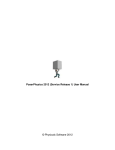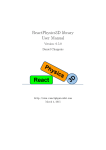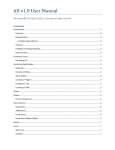Download Bullet physics engine
Transcript
11/22/2011 From the User Manual “Bullet Physics is a professional open source collision detection, rigid body and soft body dynamics library. The library is free for commercial use under the ZLib license.” Intro to Bullet Physics Ian Parberry 2 Main Features Main Features • Open source C++ code under Zlib license and free for any commercial use on all platforms including PLAYSTATION 3, XBox 360, Wii, PC, Linux, Mac OSX and iPhone • Discrete and continuous collision detection including ray and convex sweep test. Collision shapes include concave and convex meshes and all basic primitives • Fast and stable rigid body dynamics constraint solver, vehicle dynamica, character controller and slider, hinge, generic 6DOF and cone twist constraint for ragdolls • Soft Body dynamics for cloth, rope and deformable volumes with two‐way interaction with rigid bodies, including constraint support • Maya Dynamica plugin, Blender integration, COLLADA physics import/export support 3 Where is it Used? 4 http://bulletphysics.org 5 6 1 11/22/2011 Download the Zip File 7 8 9 10 http://bulletphysics.com /Bullet/BulletFull/ 11 12 2 11/22/2011 Adding Bullet Physics to Your Code Add these Projects to your Solution: BulletDynamics.vcxproj BulletCollision.vcxproj LinearMath.vcxproj 13 14 Adding Bullet Physics to your Code • Add the include path: Bullet-2.79\src • Add the library path: Bullet-2.79\lib • Add to your source file the line #include "btBulletDynamicsCommon.h" More… 15 16 More… 17 18 3 11/22/2011 More… 19 20 Adding Bullet Physics to Your Code Adding Bullet Physics to Your Code • Check out CcdPhysicsDemo how to create a btDiscreteDynamicsWorld , btCollisionShape, btMotionState and btRigidBody. • Each frame call the stepSimulation on the dynamics world, and synchronize the world transform for your graphics object. Basic order of operations: • Create Core Objects • Physics Loop Stuff (repeat until done) • Clean up 21 22 Core Objects • • • • • Physics Loop Stuff btDefaultCollisionConfiguration btCollisionDispatcher btBroadphaseInterface btSequentialImpulseConstraintSolver btDiscreteDynamicsWorld 1. 2. 3. 4. 23 Add rigid bodies, soft bodies, etc. Modify physics parameters Step simulation Return to Step 1, until end of Physics Loop. 24 4 11/22/2011 Cleanup Software Design 1. Delete objects created in Physics Loop 2. Clear various arrays 3. Delete core objects Bullet has been designed to be customizable and modular. The developer can, for example, • use only the collision detection component • use the rigid body dynamics component without soft body dynamics component • use only small parts of a the library and extend the library in many ways 25 Components 26 Rigid Body Physics Pipeline 27 28 collisionConfiguration and dispatcher Dynamics World A dynamics world provides a high level interface that manages your physics objects and constraints, and implements the update of all objects each frame. //default setup for memory, collision btDefaultCollisionConfiguration* collisionConfiguration = new btDefaultCollisionConfiguration(); btDiscreteDynamicsWorld* dynamicsWorld = new btDiscreteDynamicsWorld( dispatcher, overlappingPairCache, solver, collisionConfiguration); //use default collision dispatcher btCollisionDispatcher* dispatcher = new btCollisionDispatcher( collisionConfiguration); Next: How the parameters were created. 29 30 5 11/22/2011 overlappingPairCache and solver Adding Objects Create a btRigidBody and add it to the btDynamicsWorld. To construct a btRigidBody or btCollisionObject, you need to provide: • Mass, positive for dynamic moving objects and zero for static objects • CollisionShape, like a Box, Sphere, Cone, Convex Hull or Triangle Mesh • Material properties like friction and restitution //btDbvtBroadphase is a good general //purpose broadphase btBroadphaseInterface* overlappingPairCache = new btDbvtBroadphase(); //the default constraint solver btSequentialImpulseConstraintSolver* solver = new btSequentialImpulseConstraintSolver; 32 31 mass, localInertia and myMotionState Adding a Rigid Body body btRigidBody::btRigidBodyConstructionInfo rbInfo(mass, myMotionState, colShape, localInertia); btScalar mass(1.f); btVector3 localInertia(0, 0, 0); btTransform startTransform; startTransform.setIdentity(); startTransform.setOrigin( btVector3(2, 10, 0)); btDefaultMotionState* myMotionState = new btDefaultMotionState( startTransform); btRigidBody* body = new btRigidBody(rbInfo); dynamicsWorld->addRigidBody(body); 33 34 Frame Update colShape • Once a frame, call stepSimulation on the dynamics world. • The btDiscreteDynamicsWorld automatically takes into account variable timestep by performing interpolation instead of simulation for small timesteps. • It uses an internal fixed timestep of 60 Hertz. • stepSimulation will perform collision detection and physics simulation. • It updates the world transform for active objects by calling the btMotionState’s setWorldTransform. btCollisionShape* colShape = new btSphereShape(btScalar(1.)); colShape->calculateLocalInertia( mass, localInertia); 35 36 6 11/22/2011 Rigid Body Dynamics Object Types Rigid body dynamics is implemented on top of the collision detection module. It adds forces, mass, inertia, velocity and constraints. • btRigidBody is the main rigid body object. • Moving objects have non‐zero mass and inertia. • btRigidBody is derived from btCollisionObject, so it inherits its world transform, friction and restitution, and adds linear and angular velocity. • btTypedConstraint is the base class for rigid body constraints, including – – – – – There are 3 different types of objects in Bullet: 1. Dynamic (moving) rigid bodies • positive mass • every simulation frame it will update its world transform 2. Static rigid bodies • zero mass • cannot move but can collide 3. Kinematic rigid bodies btHingeConstraint, btPoint2PointConstraint, btConeTwistConstraint, btSliderConstraint, and btGeneric6DOFconstraint. • zero mass • can be animated by the user, but there will be only one‐ way interaction: dynamic objects will be pushed away, but there is no influence from them. 37 38 Center of Mass MotionState • The world transform of a rigid body is in Bullet always equal to its center of mass, and its basis also defines its local frame for inertia. • The local inertia tensor depends on the shape, and the btCollisionShape class provides a method to calculate the local inertia, given a mass. • This world transform has to be a rigid body transform, which means it should contain no scaling, shear etc. • If the collision shape is not aligned with the center of mass transform, it can be shifted to match with a btCompoundShape, using the child transform to shift the child collision shape. • MotionStates are a way for Bullet to get the world transform of objects being simulated into the rendering part of your game. • Your game loop will iterate through all the objects before each frame render. For each object, update the position of the render object from the physics body using MotionStates. • Other benefits of MotionStates: – Computation involved in moving bodies around is only done for bodies that have moved. – You don't just have to do render stuff in them. They could be effective for notifying network code that a body has moved and needs to be updated across the network. – Interpolation is usually only meaningful in the context of something visible on‐screen. Bullet manages body interpolation through MotionStates. 39 MotionState 40 btDefaultMotionState MotionStates are used in two places in Bullet. 1. When the body is first created. Bullet: • Grabs the initial position of the body from the MotionState when the body enters the simulation • Calls getWorldTransform with a reference to the variable it wants you to fill with transform information • Calls getWorldTransform on kinematic bodies. 2. After the first update, during simulation. Bullet calls the MotionState for a body to move it around • Bullet calls setWorldTransform with the transform of the body, for you to update your object appropriately • To implement one, simply inherit btMotionState and override getWorldTransform and setWorldTransform. 41 • Although recommended, it is not necessary to derive your own MotionState from btMotionState interface. • Bullet provides a default MotionState that you can use for this. Simply construct it with the default transform of your body: btDefaultMotionState* ms = new btDefaultMotionState(); 42 7 11/22/2011 Render Frames and Physics Frames By default, Bullet physics simulation runs at an internal fixed frame rate of 60 Hertz. Your render loop will have a different or even variable frame rate. To decouple the render frame rate from the simulation frame rate, an automatic interpolation method is built into stepSimulation: • If the application delta time is smaller then the internal fixed time step, Bullet will interpolate the world transform and send it to the btMotionState, without performing physics simulation. • If the application time step is larger than 60Hz, one or more simulation steps can be performed during each stepSimulation call. The user can limit the maximum number of simulation steps by passing a maximum value as second argument. Some Bullet Physics Demos 1. 2. 3. 4. 5. Cloth (DirectX 11) Cloth (OpenCL) Spiders Forklift Ragdoll 43 44 45 46 47 48 8 11/22/2011 49 50 9

















